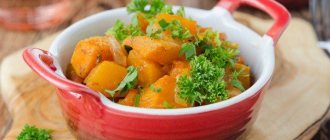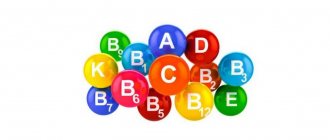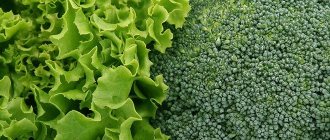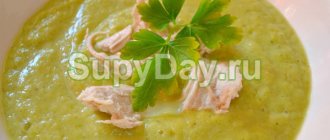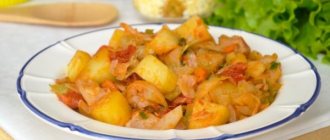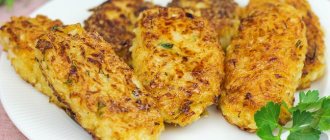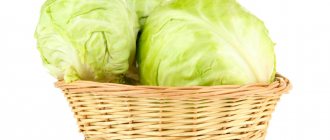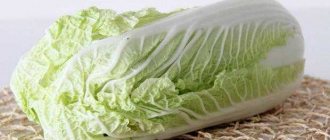The large cabbage family is a very healthy vegetable. Just look at white cabbage, which contains a large amount of vitamin C, which, when pickled, is one of the main winter sources of vitamins. Its relatives, cauliflower and broccoli, are also very healthy. And from them you can prepare a large number of autumn-winter dishes.
Broccoli is rightfully considered one of the healthiest vegetables. Record holder for vitamin A content, rich in B vitamins, contains a lot of calcium, iron and the daily requirement of vitamin C per 100 grams. Broccoli is recommended for the diet of heart patients, for removing cholesterol from the body, and for normalizing blood sugar levels.
Question and Answer Is it possible to freeze cabbage? Cauliflower contains a lot of fiber, coarse dietary fiber. Cauliflower also contains a lot of vegetable protein and vitamins: group B, C, K, PP, microelements, such as potassium, copper, iron, phosphorus. By the way, 100 grams of cauliflower contains the daily requirement of vitamin C.
Both vegetables are excellent as side dishes, they make excellent pureed soups and simply puree to accompany meat or fish.
Both broccoli and cauliflower need to be cooked fairly quickly. One of the best ways is blanching. That is, boiling in boiling water for a short time, 2-3 minutes. If you leave cabbage on the fire, it will become limp and ugly, but if you cook it quickly, it will be crispy, elastic, and will retain maximum benefits.
After blanching, it is best to place the cabbage on ice to stop the heat treatment process. In this case, the broccoli will retain its bright color and the cauliflower will retain its shape.
You can also bake or fry cabbage after blanching. It is often fried on the grill, and it turns out both tasty and beautiful.
General rules
Broccoli is perceived by many as a delicacy, some are indifferent to it, and some cannot eat it because of the smell and bland, inexpressive taste. However, everyone knows the benefits of this type of cabbage for the body. It is not for nothing that it was chosen for dietary nutrition for the purpose of weight loss, because:
- its calorie content is only 34 kcal;
- the high content of dietary fiber helps to quickly satisfy the feeling of hunger;
- Like many other green vegetables, cabbage is a food with a negative calorie content - to assimilate, the body spends more calories than it takes in with this product.
100 g of this type of cabbage contains 2.8 g of protein, 0.4 g of fat and 6.6 g of carbohydrates. This is a food product that contains essential amino acids for the body. Including it in the diet is good for health due to its rich vitamin and mineral composition. The product is dominated by ascorbic acid (100 g of cabbage contains 99.1% of the daily requirement), vitamin K (84.7%) and vitamin A (42.9%), as well as other B vitamins, including folates ( 15.8%) and pantothenic acid ( vitamin B5 ).
Of the macroelements, potassium ranks first in content, followed by phosphorus and magnesium. Among the microelements, manganese, copper, selenium and iron should be highlighted. Vitamins and minerals are actively involved in metabolism .
- Vitamin B5 is involved in all types of metabolism, as well as cholesterol metabolism. It is necessary for the synthesis of hormones and promotes better absorption of amino acids in the intestines.
- Manganese affects metabolism and takes part in the metabolism of amino acids, lipids and carbohydrates.
- Potassium regulates water and electrolyte balance and is necessary for regulating blood pressure and conducting nerve impulses.
- Copper stimulates the absorption of proteins and carbohydrates.
A six-day broccoli diet (main part) allows you to reduce weight up to 4-5 kg, and in 10 days (additional) you can lose up to 7 kg. It contains nutrition plans for all ten days (five modes in total). It is the same every two days and does not repeat for ten days. It is not recommended to change the composition of foods per day and alternating diets.
In general, the diet is low-calorie and quite strict. It is dominated by cabbage (three meals), which is supplemented with fish, poultry, potatoes, beef, bread, tomatoes, sour cream, olive oil, herbs, bell peppers, onions, but not in every meal. There are several days when only stewed cabbage is consumed during the day, which is quite difficult to tolerate, since the caloric content of the diet on these days is 520-620 kcal.
If boiled beef, fish or chicken fillet is added to the diet, the energy value of the diet increases by 300, 150 and 140 kcal, respectively, and amounts to 660-920 kcal, which is also lower than the cost of basal metabolism, which is 1200 kcal. At meals when only cabbage is present, the serving is 200-250 g; if it is supplemented with other products, then the main serving is reduced to 100-150 g.
The basic rules for preparing this vegetable are short heat treatment for 3-5 minutes, immersing it in boiling water and a minimum amount of salt. Cabbage broth contains purines, which are a source of uric acid. It accumulates in various organs and causes the disease gout . Therefore, if the level of uric acid in the body is high, it should not be consumed. This vegetable will bring the greatest benefit to the body when eaten fresh, seasoned with a little salt and lemon juice. Between meals you are allowed to consume low-fat yogurt, kefir or yogurt. The drinking regime includes ordinary purified water and mineral water without gas.
Broccoli - beneficial properties for weight loss
Before you begin your path to slimness, it is worth studying the properties of broccoli for weight loss. Almost all of the beneficial substances included in its composition are actively included in the metabolic processes of the body, including fat. Due to their acceleration, gradual weight loss begins. How is this ensured? Weight loss occurs thanks to:
- Vitamin C and calcium. There are a lot of them in the composition. These substances are catalysts for metabolism - it accelerates and does not allow waste, toxins and fat deposits to linger in the body.
- Low calorie. 100 g of this vegetable contains only 30 kcal, but at the same time it has high mineral and vitamin value, which makes the vegetable a valuable product for weight loss.
- B vitamins. They interact with dietary fiber and chlorophyll, which leads to complete cleansing of the body.
- Coarse dietary fiber filled with water. Their content can help to quickly satisfy hunger, and for a long time.
Vitamin composition
The beneficial properties of broccoli, including in relation to weight loss, are due to. The composition of broccoli is superior to many foods in terms of microelements and vitamins. In this case, the calorie content of the product is considered negative. One small inflorescence contains:
- macroelements - phosphorus, magnesium, calcium, sodium, calcium;
- vitamins - groups B, A, E, PP, C;
- trace elements - manganese, zinc, copper, iron, selenium.
Authorized Products
The list of products for this diet is strictly limited:
- boiled (stewed) and fresh broccoli in portions from 100 to 250 g;
- boiled low-fat fish in the amount of 100-150 g;
- beef, boiled chicken fillet 100-150 g;
- broccoli soup with chicken broth 200-250 ml;
- eggs in the amount of 2 pieces;
- rye bread, two slices;
- tomatoes, lettuce peppers, garlic, onions, carrots on certain days;
- olive oil no more than 2 tablespoons in dishes on allowed days;
- low-fat fermented milk drinks, 2-3 glasses per day;
- green and black tea without sugar, tomato juice, purified water.
Table of permitted products
| Proteins, g | Fats, g | Carbohydrates, g | Calories, kcal | |
Vegetables and greens | ||||
| greenery | 2,6 | 0,4 | 5,2 | 36 |
| boiled broccoli | 3,0 | 0,4 | 4,0 | 27 |
| boiled potatoes | 2,0 | 0,4 | 16,7 | 82 |
| bulb onions | 1,4 | 0,0 | 10,4 | 41 |
| carrot | 1,3 | 0,1 | 6,9 | 32 |
| salad pepper | 1,3 | 0,0 | 5,3 | 27 |
| salad | 1,2 | 0,3 | 1,3 | 12 |
| tomatoes | 0,6 | 0,2 | 4,2 | 20 |
| garlic | 6,5 | 0,5 | 29,9 | 143 |
Bakery products | ||||
| Rye bread | 6,6 | 1,2 | 34,2 | 165 |
Dairy | ||||
| skim milk | 2,0 | 0,1 | 4,8 | 31 |
| kefir 1% | 2,8 | 1,0 | 4,0 | 40 |
| natural yogurt 2% | 4,3 | 2,0 | 6,2 | 60 |
Meat products | ||||
| beef | 18,9 | 19,4 | 0,0 | 187 |
Bird | ||||
| boiled chicken fillet | 30,4 | 3,5 | 0,0 | 153 |
Eggs | ||||
| chicken eggs | 12,7 | 10,9 | 0,7 | 157 |
Fish and seafood | ||||
| boiled fish | 17,3 | 5,0 | 0,0 | 116 |
Oils and fats | ||||
| olive oil | 0,0 | 99,8 | 0,0 | 898 |
Non-alcoholic drinks | ||||
| mineral water | 0,0 | 0,0 | 0,0 | — |
| green tea | 0,0 | 0,0 | 0,0 | — |
| black tea | 20,0 | 5,1 | 6,9 | 152 |
Juices and compotes | ||||
| carrot juice | 1,1 | 0,1 | 6,4 | 28 |
| cucumber juice | 0,8 | 0,1 | 2,5 | 14 |
| tomato juice | 1,1 | 0,2 | 3,8 | 21 |
| * data is per 100 g of product | ||||
Gray cabbage soup (cabbage soup from shchanitsa)
You will need : 700 g of pickled cauliflower leaves and/or broccoli, 500 g of pork with lard, 4 potatoes, 1 large onion, 1 tbsp. tomato paste, salt and dried herbs to taste (dill, bay leaf).
Cooking . Wash the meat and dry it.
Pour pickled, finely chopped cauliflower and/or broccoli leaves along with a whole piece of meat into a saucepan with cold water (about 2-2.5 liters), put on fire, add salt, and bring to a boil.
As soon as the mixture boils, reduce the heat, add tomato paste, cover with a lid and cook for 50-60 minutes (until the meat is completely cooked). Remove the pan from the heat.
Take out a piece of meat, use a fork to separate it into fibers and put it back into the cabbage soup. Add chopped dry herbs and bay leaf, boil the soup again and turn off the heat.
Pour the gray cabbage soup into plates and serve hot with sour cream.
You can add pickled cabbage leaves in any proportion to cauliflower and/or broccoli leaves in gray cabbage soup.
Fully or partially limited products
- fatty meats and fish;
- fried foods;
- sugar and all kinds of sweets, any baked goods and flour products;
- fermented milk products with high fat content;
- restriction of salt and fats.
Table of prohibited products
| Proteins, g | Fats, g | Carbohydrates, g | Calories, kcal | |
Vegetables and greens | ||||
| radish | 1,2 | 0,1 | 3,4 | 19 |
| white radish | 1,4 | 0,0 | 4,1 | 21 |
| red radish | 1,2 | 0,1 | 3,4 | 20 |
| black radish | 1,9 | 0,2 | 6,7 | 35 |
| spinach | 2,9 | 0,3 | 2,0 | 22 |
| sorrel | 1,5 | 0,3 | 2,9 | 19 |
Fruits | ||||
| bananas | 1,5 | 0,2 | 21,8 | 95 |
Berries | ||||
| grape | 0,6 | 0,2 | 16,8 | 65 |
Mushrooms | ||||
| mushrooms | 3,5 | 2,0 | 2,5 | 30 |
Nuts and dried fruits | ||||
| raisin | 2,9 | 0,6 | 66,0 | 264 |
Cereals and porridges | ||||
| semolina | 10,3 | 1,0 | 73,3 | 328 |
| white rice | 6,7 | 0,7 | 78,9 | 344 |
Flour and pasta | ||||
| pasta | 10,4 | 1,1 | 69,7 | 337 |
Confectionery | ||||
| jam | 0,3 | 0,2 | 63,0 | 263 |
| jam | 0,3 | 0,1 | 56,0 | 238 |
| candies | 4,3 | 19,8 | 67,5 | 453 |
| pastry cream | 0,2 | 26,0 | 16,5 | 300 |
| cookie | 7,5 | 11,8 | 74,9 | 417 |
Ice cream | ||||
| ice cream | 3,7 | 6,9 | 22,1 | 189 |
Cakes | ||||
| cake | 4,4 | 23,4 | 45,2 | 407 |
Chocolate | ||||
| chocolate | 5,4 | 35,3 | 56,5 | 544 |
Raw materials and seasonings | ||||
| mustard | 5,7 | 6,4 | 22,0 | 162 |
| mayonnaise | 2,4 | 67,0 | 3,9 | 627 |
Dairy | ||||
| milk 3.6% | 2,8 | 3,6 | 4,7 | 62 |
| milk 4.5% | 3,1 | 4,5 | 4,7 | 72 |
| cream | 2,8 | 20,0 | 3,7 | 205 |
| sour cream 25% (classic) | 2,6 | 25,0 | 2,5 | 248 |
Cheeses and cottage cheese | ||||
| cheese | 24,1 | 29,5 | 0,3 | 363 |
| cottage cheese 11% | 16,0 | 11,0 | 1,0 | 170 |
| cottage cheese 18% (fat) | 14,0 | 18,0 | 2,8 | 232 |
Meat products | ||||
| pork | 16,0 | 21,6 | 0,0 | 259 |
| pork liver | 18,8 | 3,6 | 0,0 | 108 |
| pork kidneys | 13,0 | 3,1 | 0,0 | 80 |
| pork fat | 1,4 | 92,8 | 0,0 | 841 |
| salo | 2,4 | 89,0 | 0,0 | 797 |
| beef liver | 17,4 | 3,1 | 0,0 | 98 |
| beef kidneys | 12,5 | 1,8 | 0,0 | 66 |
| beef brains | 9,5 | 9,5 | 0,0 | 124 |
Sausages | ||||
| smoked sausage | 16,2 | 44,6 | 0,0 | 466 |
| smoked sausage | 9,9 | 63,2 | 0,3 | 608 |
| sausages | 10,1 | 31,6 | 1,9 | 332 |
| sausages | 12,3 | 25,3 | 0,0 | 277 |
Bird | ||||
| smoked chicken | 27,5 | 8,2 | 0,0 | 184 |
| duck | 16,5 | 61,2 | 0,0 | 346 |
| smoked duck | 19,0 | 28,4 | 0,0 | 337 |
| goose | 16,1 | 33,3 | 0,0 | 364 |
Fish and seafood | ||||
| smoked fish | 26,8 | 9,9 | 0,0 | 196 |
| salted fish | 19,2 | 2,0 | 0,0 | 190 |
| Red caviar | 32,0 | 15,0 | 0,0 | 263 |
| black caviar | 28,0 | 9,7 | 0,0 | 203 |
| canned fish | 17,5 | 2,0 | 0,0 | 88 |
| cod (liver in oil) | 4,2 | 65,7 | 1,2 | 613 |
Oils and fats | ||||
| animal fat | 0,0 | 99,7 | 0,0 | 897 |
| cooking fat | 0,0 | 99,7 | 0,0 | 897 |
Non-alcoholic drinks | ||||
| instant coffee dry | 15,0 | 3,5 | 0,0 | 94 |
| black tea | 20,0 | 5,1 | 6,9 | 152 |
| * data is per 100 g of product | ||||
Menu (Power Mode)
Meals are designed for 3 main meals. It is important to follow your diet and portion sizes. Between meals, if you feel hungry, you can drink fermented milk drinks. The menu must be completed in the following order.
The first and second day of the diet
| Breakfast |
|
| Dinner |
|
| Dinner |
|
Third and fourth days
| Breakfast |
|
| Dinner |
|
| Dinner |
|
Fifth and sixth days
| Breakfast |
|
| Dinner |
|
| Dinner |
|
Seventh and eighth days
| Breakfast |
|
| Dinner |
|
| Dinner |
|
The ninth and tenth day of the diet
| Breakfast |
|
| Dinner |
|
| Dinner |
|
Broccoli puree for garnish
Recipe by Evgeny Veselov, chef of Forte Bello restaurants
Photo: Forte Bello Restaurant
400 g broccoli
Olive oil
4 teeth garlic
Related news
Broccoli helps prevent most forms of arthritis - scientists 50-70 g butter
3-4 sprigs of thyme
Salt and pepper
Step 1: You will need fresh or frozen broccoli (if using fresh broccoli, cut off the stems, leaving only the florets).
Step 2. To preserve color, broccoli must be blanched - place the florets in boiling water for 30 seconds, then immediately place in cold water or ice.
Step 3. Heat a frying pan and fry the broccoli in olive oil for two minutes over high heat, after adding crushed garlic cloves and thyme sprigs.
Step 4. At the end of frying, add 50-70 grams of butter and wait until it melts.
Step 5. Remove the garlic and thyme from the fried broccoli, and blend the florets in a blender to a puree consistency.
Step 6. Add salt and pepper to taste, place the puree on a plate, and place the perch fillet on top. Serve with thyme and sun-dried tomato pesto (to make pesto, simply place the entire contents of a jar of sun-dried tomatoes in a blender and blend).
Broccoli Recipes for Diet
If you deviate somewhat from the strict diet, but keep the main product in it, you can prepare various dietary dishes based on this healthy vegetable. For example, you can add tomatoes, herbs, onions and a clove of garlic to a dietary broccoli puree soup. You can also prepare cream soup, which differs from puree soup by the presence of cream or milk in its composition. Of course, such a dish will be tastier, but also higher in calories due to the cream.
You can also eat other dishes in your daily diet, but the main thing is that the basic principle of heat treatment is followed - steaming, boiling or baking without excess fat and with a minimum of salt.
Recipe for dietary puree soup with broccoli and other vegetables
Ingredients: 250 g broccoli, 1 parsley root, 200 g stalk celery, onions, one bell pepper (yellow or green).
Chop the vegetables, pour boiling water over them and boil until soft. Drain the vegetable broth and grind the vegetables in a blender. Add broth to the consistency you need, add a little salt, season with lemon juice and sour cream, if your diet allows. Can be served with chopped herbs.
Cabbage baked with bell peppers and tomatoes
Ingredients: 300 g cabbage, one pepper, 2 tomatoes, basil, onions, 3 tbsp. sour cream, egg.
The cabbage is separated into inflorescences and blanched for 2-3 minutes in boiling water. Cut sweet peppers and onions into rings, mix with cabbage, add a little salt and add chopped basil. Place the vegetable mixture in a baking dish, top with tomatoes cut into rings and pour in sour cream and egg filling. Sour cream can be replaced with low-fat kefir or milk. Place in the oven for 15-20 minutes.
How to cook broccoli for weight loss
It is important not only to use broccoli when losing weight, but also to cook it correctly. For frying, it is better to use olive oil, because it does not emit harmful carcinogens. It is better to stew, boil or steam the inflorescences. This processing will preserve more nutrients in the vegetable, and even without sunflower oil, the food will be much healthier and suitable for dietary nutrition.
For a couple
All models of multicookers have a steam cooking mode. To do this, water is poured into their main bowl. The products themselves are placed in a container for steaming. It turns out something similar to a water bath. Steamed broccoli in a slow cooker is prepared according to the same principle:
- Wash the inflorescences and divide them into smaller ones.
- Place them in a steaming container and sprinkle lemon juice or lemon-garlic sauce on top.
- Fill the main bowl of the multicooker with water.
- Turn on the “Steam” mode. When the water boils, place a container with vegetables on top and cook for about 40-50 minutes.
Baked
Another useful way to prepare any food is baking. In this case, the products also retain most of their constituent vitamins and microelements. Broccoli baked in the oven is no exception. It can be cooked in its pure form or supplemented with eggs, cheese, garlic - you will still get a dietary dish. The cooking principle is as follows:
- Wash the inflorescences, divide into small ones and blanch in boiling water for a couple of minutes.
- Next, transfer them to an oiled baking sheet; you can sprinkle cheese on top or sprinkle with soy sauce.
- Send to bake for 1 hour at 160 degrees.
Boiled
The simplest and most accessible method of preparation is boiling. It is important not to exceed the recommended time. Boiled broccoli is cooked in slightly salted water for no more than 3 minutes. If the inflorescences remain harsh, then you can increase this value to 5-7 minutes. It is important not to pour too much water - it should be slightly higher than the level of the contents in the pan.
- Making delicious yellow plum compote for the winter
- What's fashionable in men's clothing right now?
- New generation broad-spectrum antibiotics - list of names
Advantages and disadvantages
| pros | Minuses |
|
|
Broccoli diet: reviews and results
Nutritionists are against the use of low-calorie diets, which lead to a slowdown in metabolism and rapid restoration of lost weight. In addition, this diet can only be followed by people who do not have gastrointestinal pathology. An abundance of fiber, although thermally processed, can cause exacerbation of colitis and peptic ulcers . Only those with willpower can complete it to the end, since it is quite tough if you strictly follow all the rules. It should not be repeated more than twice a year due to the imbalance of the diet. Analyzing the pros and cons, we can conclude that eating according to such a system has more negative aspects than positive ones.
It is often noted that this diet is difficult to tolerate and many were bothered by a constant feeling of hunger. This brought discomfort and reluctance to continue the diet further or resort to it again. Reviews indicate that many could not stand the strict menu and the strict alternation of the diet by day. In connection with this, they either broke down and left the diet, or supplemented it with other foods (mainly chicken and fish). There are reviews in which this diet is called “torture.”
However, this healthy vegetable should be included in the diet as often as possible, especially during its ripening season.
- “... This is the healthiest cabbage, but I didn’t dare go on a full diet because I don’t like mono-diets. I can’t sit on one product for a long time. The diet is very low in protein. I think that it is possible to go without eating protein foods for one or two days, but every day is unacceptable. It is better to include this type of healthy cabbage in your diet more often. I gave myself broccoli fasting days and tolerated them normally. The intestines worked like clockwork. I lost 700 g in a day.”
- “... I love broccoli, but it’s in season in the summer - then it’s more beneficial. And some even tolerate the smell. I arranged a diet for myself for a week, only supplementing it a little with protein dishes. I think it’s difficult to eat it alone. I ate three times a day, but always with protein. For example, if I baked it, I added cottage cheese with a raw egg. I made a baked omelet with a broccoli base or added a boiled egg and hard cheese to a salad with this vegetable. More often it was simply boiled and consumed with boiled meat or fish. In all these cases, it turned out tastier, more satisfying and healthier. Perhaps if I had stuck to the diet strictly, I would have lost more, but as it is, it’s only 3 kg in a week. In addition to this, I did physical labor at the dacha, as I was on vacation at that time. By the way, I ate my own cabbage, fresh and without chemicals.”
- “... I, too, was able to withstand only a week and with a slight correction of the diet. Indeed, not everyone is able to withstand eating the same product three times a day, no matter how beloved and healthy it is. All this gets boring quickly. I think it is difficult to limit yourself to one pepper a day and two tomatoes. Therefore, I added other vegetables to salads (they are also low-calorie), vegetable oil and herbs, so that it would not be so boring. I additionally included eggs, made omelets (although they are not in the diet) and baked them with other vegetables, cheese and cottage cheese, which are also not included in the diet. I liked the puree soups, but I also included a piece of chicken in them, otherwise it doesn’t turn out satisfying and after an hour it starts to suck in the pit of my stomach. As a result of my week-long “efforts,” I managed to lose 2.5 kg.”
Shchanitsa (aka khryapa, aka kroshevo) from cauliflower or broccoli leaves (pickle made from leaves)
You will need : 2.5 kg of fresh cauliflower and/or broccoli leaves, 2-3 large carrots, 1 tbsp. salt without a slide, water, rye flour.
Cooking . Sort out fresh cauliflower and/or broccoli leaves, wash under running water, and dry on a paper towel. If necessary, cut out the roughest parts - veins.
First, chop the leaves into strips, and then chop (chop) them finely by hand with a knife or in a food processor.
Peel the carrots, wash and grate on a fine grater.
Mix the carrot and cabbage mixture, add salt, place in a wide bowl with a little rye flour sprinkled on the bottom, pour over boiling water (1 cup).
Cover the mass with oppression and leave it to languish in a warm place for 3-5 days, removing the oppression from time to time and kneading it with your hands, as well as piercing the mass with skewers. If little juice comes out, you can add water a little at a time.
Store the finished crumble in the refrigerator in glass jars covered with nylon lids, or frozen in bags in the freezer.
Serve cold as an appetizer on its own or store for later preparation of hot dishes.
This is the simplest cabbage leaf crumble recipe. If desired, you can add beets, garlic, dill, black pepper, bay leaf, sweet pepper, coriander, sugar, vinegar, etc. during the process.
